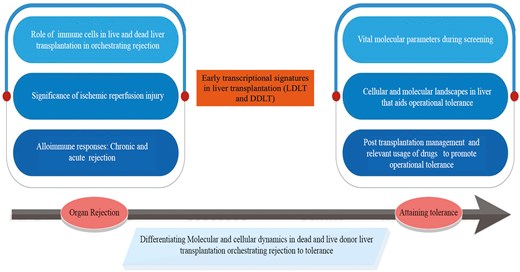-
Views
-
Cite
Cite
Geethanjali Dhayanithy, Subathra Radhakrishnan, Catherine Ann Martin, Josette Caroline Martin, Abdul Rahman Hakeem, Dinesh Jothimani, Subbaraya Narayana Kalkura, Mohamed Rela, Understanding immunological insights of liver transplantation: a practice for attaining operational tolerance, Clinical and Experimental Immunology, Volume 219, Issue 1, 2025, uxae125, https://doi.org/10.1093/cei/uxae125
Close - Share Icon Share
Abstract
Liver transplantation has been at the forefront of medical research, with efforts concentrated on understanding the intricate cellular and molecular dynamics involved this complex procedure. This body of work has chronicled critical clinical advancements, identified challenges, and highlighted progressive improvements in surgical practices. These concerted efforts have significantly contributed to the evolution and enhancement of liver transplantation, elevating it to its current level of sophistication. A successful liver transplant now demands an integrated, multidisciplinary approach that includes not only expanding the donor pool from deceased to living donors but also embracing advances in surgical methods, efficiently managing post-transplant complications, and, importantly, achieving operational tolerance. The latter, operational tolerance, is a state wherein the recipient’s immune system is coaxed into accepting the transplanted organ without the long-term use of immunosuppressive drugs, thereby minimizing potential side effects, and improving quality of life.
Understanding the critical immune mechanisms that aim to prevent graft rejection is essential from an immunological perspective. This review aims to highlight the crucial areas of host versus graft immune responses, making a clear distinction between organs received from living and deceased donors. It examines how these immune responses, both innate and adaptive, are initiated and proposes the exploration of molecular docking sites as a strategy to curb unwanted immune reactions. Additionally, this review explores the promising potential of biomarkers in predicting graft rejection, and emphasizes the importance of achieving tolerance and the continuous quest for innovative strategies to enhance the success and longevity of liver transplants.






